An Analysis of Enterprise Resource Planning Systems and Their Benefits
VerifiedAdded on 2023/01/18
|17
|4480
|60
Report
AI Summary
This report provides a comprehensive analysis of Enterprise Resource Planning (ERP) systems, evaluating their importance, implementation processes, and associated benefits. The research explores the concept of ERP systems, their application in business management, and the challenges encountered during implementation. It emphasizes the long-term realization of ERP benefits and discusses the potential for continuous improvement beyond the initial 'go-live' phase. The report examines the different stages of ERP implementation, including problem identification, scope definition, and data migration. The report further includes case studies of Nestle and Cadbury to illustrate successful ERP implementation. It also identifies drivers and barriers for companies adopting ERP systems, concluding with an overview of the key considerations for effective ERP deployment. The report is a valuable resource for understanding the dynamics of ERP systems and their impact on organizational performance. This report is available on Desklib, a platform offering past papers and solved assignments for students.
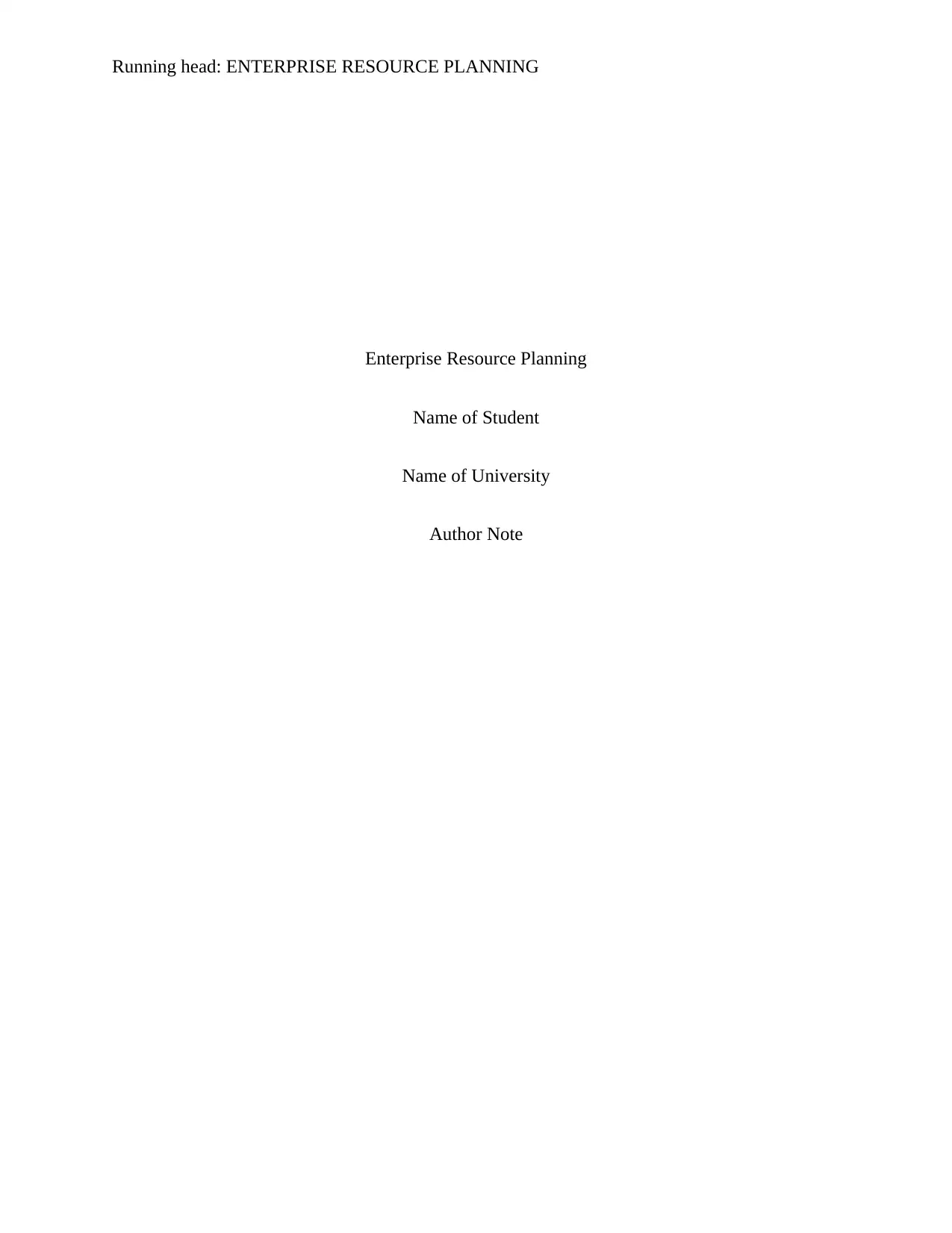
Running head: ENTERPRISE RESOURCE PLANNING
Enterprise Resource Planning
Name of Student
Name of University
Author Note
Enterprise Resource Planning
Name of Student
Name of University
Author Note
Paraphrase This Document
Need a fresh take? Get an instant paraphrase of this document with our AI Paraphraser
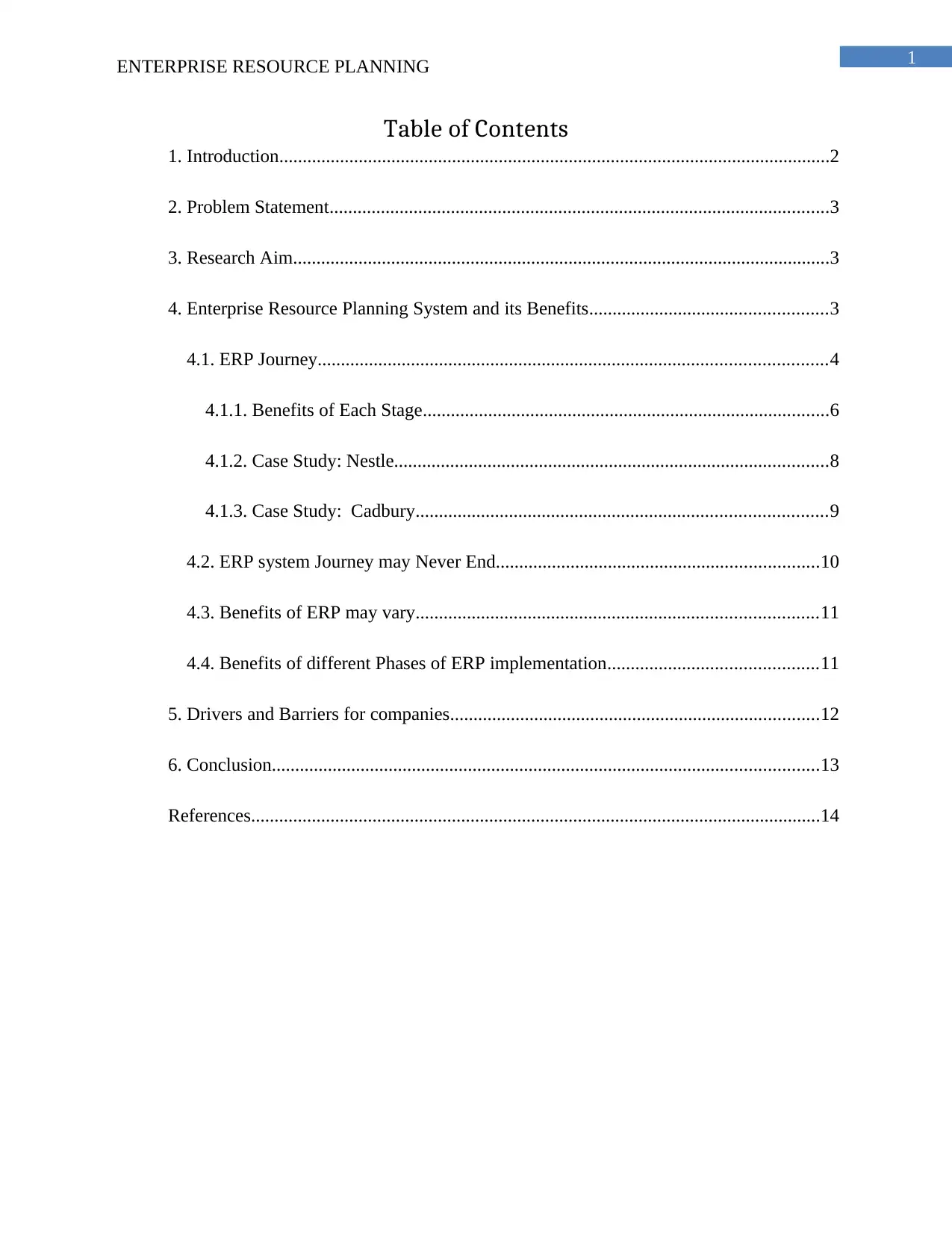
1ENTERPRISE RESOURCE PLANNING
Table of Contents
1. Introduction......................................................................................................................2
2. Problem Statement...........................................................................................................3
3. Research Aim...................................................................................................................3
4. Enterprise Resource Planning System and its Benefits...................................................3
4.1. ERP Journey.............................................................................................................4
4.1.1. Benefits of Each Stage.......................................................................................6
4.1.2. Case Study: Nestle.............................................................................................8
4.1.3. Case Study: Cadbury........................................................................................9
4.2. ERP system Journey may Never End.....................................................................10
4.3. Benefits of ERP may vary......................................................................................11
4.4. Benefits of different Phases of ERP implementation.............................................11
5. Drivers and Barriers for companies...............................................................................12
6. Conclusion.....................................................................................................................13
References..........................................................................................................................14
Table of Contents
1. Introduction......................................................................................................................2
2. Problem Statement...........................................................................................................3
3. Research Aim...................................................................................................................3
4. Enterprise Resource Planning System and its Benefits...................................................3
4.1. ERP Journey.............................................................................................................4
4.1.1. Benefits of Each Stage.......................................................................................6
4.1.2. Case Study: Nestle.............................................................................................8
4.1.3. Case Study: Cadbury........................................................................................9
4.2. ERP system Journey may Never End.....................................................................10
4.3. Benefits of ERP may vary......................................................................................11
4.4. Benefits of different Phases of ERP implementation.............................................11
5. Drivers and Barriers for companies...............................................................................12
6. Conclusion.....................................................................................................................13
References..........................................................................................................................14
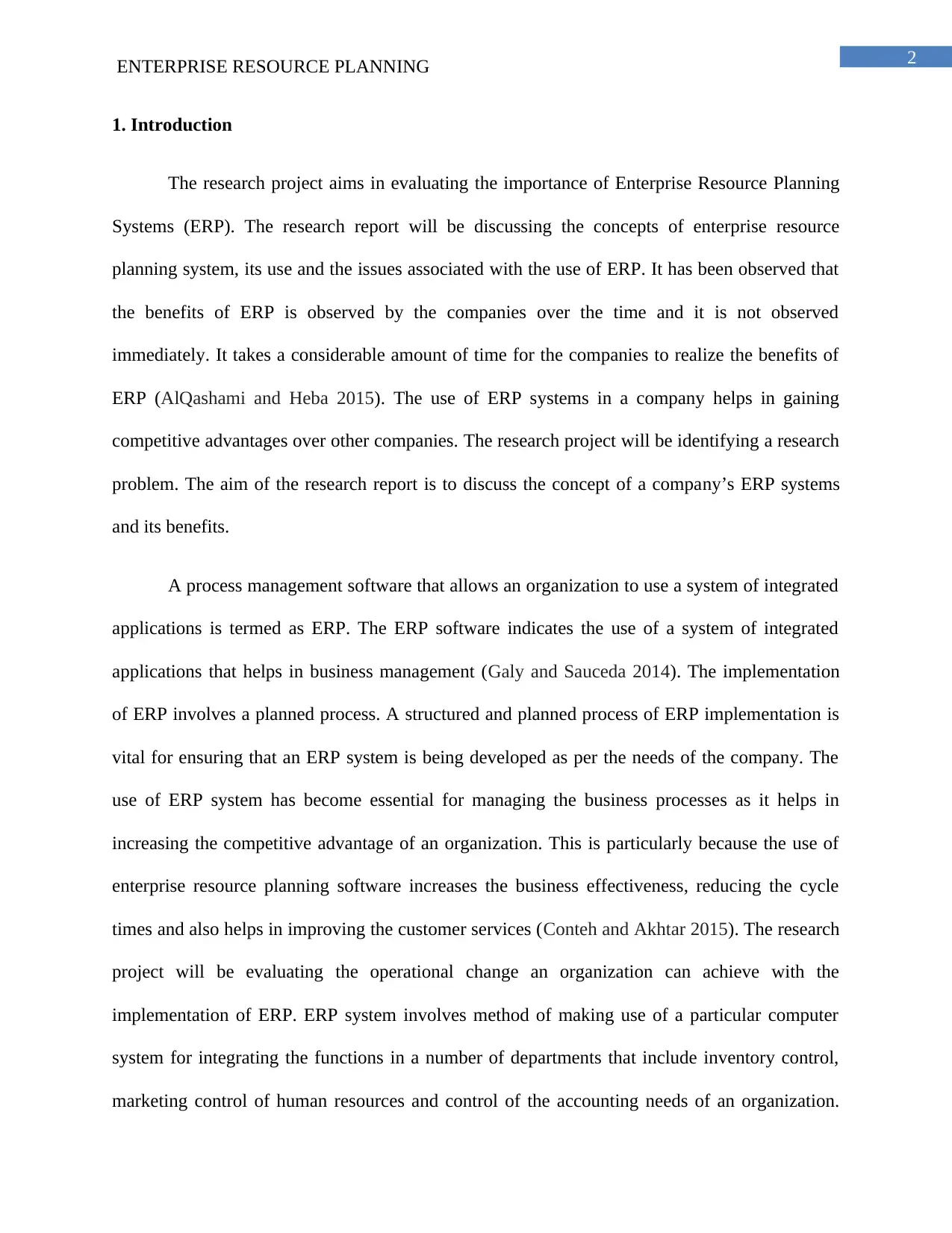
2ENTERPRISE RESOURCE PLANNING
1. Introduction
The research project aims in evaluating the importance of Enterprise Resource Planning
Systems (ERP). The research report will be discussing the concepts of enterprise resource
planning system, its use and the issues associated with the use of ERP. It has been observed that
the benefits of ERP is observed by the companies over the time and it is not observed
immediately. It takes a considerable amount of time for the companies to realize the benefits of
ERP (AlQashami and Heba 2015). The use of ERP systems in a company helps in gaining
competitive advantages over other companies. The research project will be identifying a research
problem. The aim of the research report is to discuss the concept of a company’s ERP systems
and its benefits.
A process management software that allows an organization to use a system of integrated
applications is termed as ERP. The ERP software indicates the use of a system of integrated
applications that helps in business management (Galy and Sauceda 2014). The implementation
of ERP involves a planned process. A structured and planned process of ERP implementation is
vital for ensuring that an ERP system is being developed as per the needs of the company. The
use of ERP system has become essential for managing the business processes as it helps in
increasing the competitive advantage of an organization. This is particularly because the use of
enterprise resource planning software increases the business effectiveness, reducing the cycle
times and also helps in improving the customer services (Conteh and Akhtar 2015). The research
project will be evaluating the operational change an organization can achieve with the
implementation of ERP. ERP system involves method of making use of a particular computer
system for integrating the functions in a number of departments that include inventory control,
marketing control of human resources and control of the accounting needs of an organization.
1. Introduction
The research project aims in evaluating the importance of Enterprise Resource Planning
Systems (ERP). The research report will be discussing the concepts of enterprise resource
planning system, its use and the issues associated with the use of ERP. It has been observed that
the benefits of ERP is observed by the companies over the time and it is not observed
immediately. It takes a considerable amount of time for the companies to realize the benefits of
ERP (AlQashami and Heba 2015). The use of ERP systems in a company helps in gaining
competitive advantages over other companies. The research project will be identifying a research
problem. The aim of the research report is to discuss the concept of a company’s ERP systems
and its benefits.
A process management software that allows an organization to use a system of integrated
applications is termed as ERP. The ERP software indicates the use of a system of integrated
applications that helps in business management (Galy and Sauceda 2014). The implementation
of ERP involves a planned process. A structured and planned process of ERP implementation is
vital for ensuring that an ERP system is being developed as per the needs of the company. The
use of ERP system has become essential for managing the business processes as it helps in
increasing the competitive advantage of an organization. This is particularly because the use of
enterprise resource planning software increases the business effectiveness, reducing the cycle
times and also helps in improving the customer services (Conteh and Akhtar 2015). The research
project will be evaluating the operational change an organization can achieve with the
implementation of ERP. ERP system involves method of making use of a particular computer
system for integrating the functions in a number of departments that include inventory control,
marketing control of human resources and control of the accounting needs of an organization.
⊘ This is a preview!⊘
Do you want full access?
Subscribe today to unlock all pages.

Trusted by 1+ million students worldwide
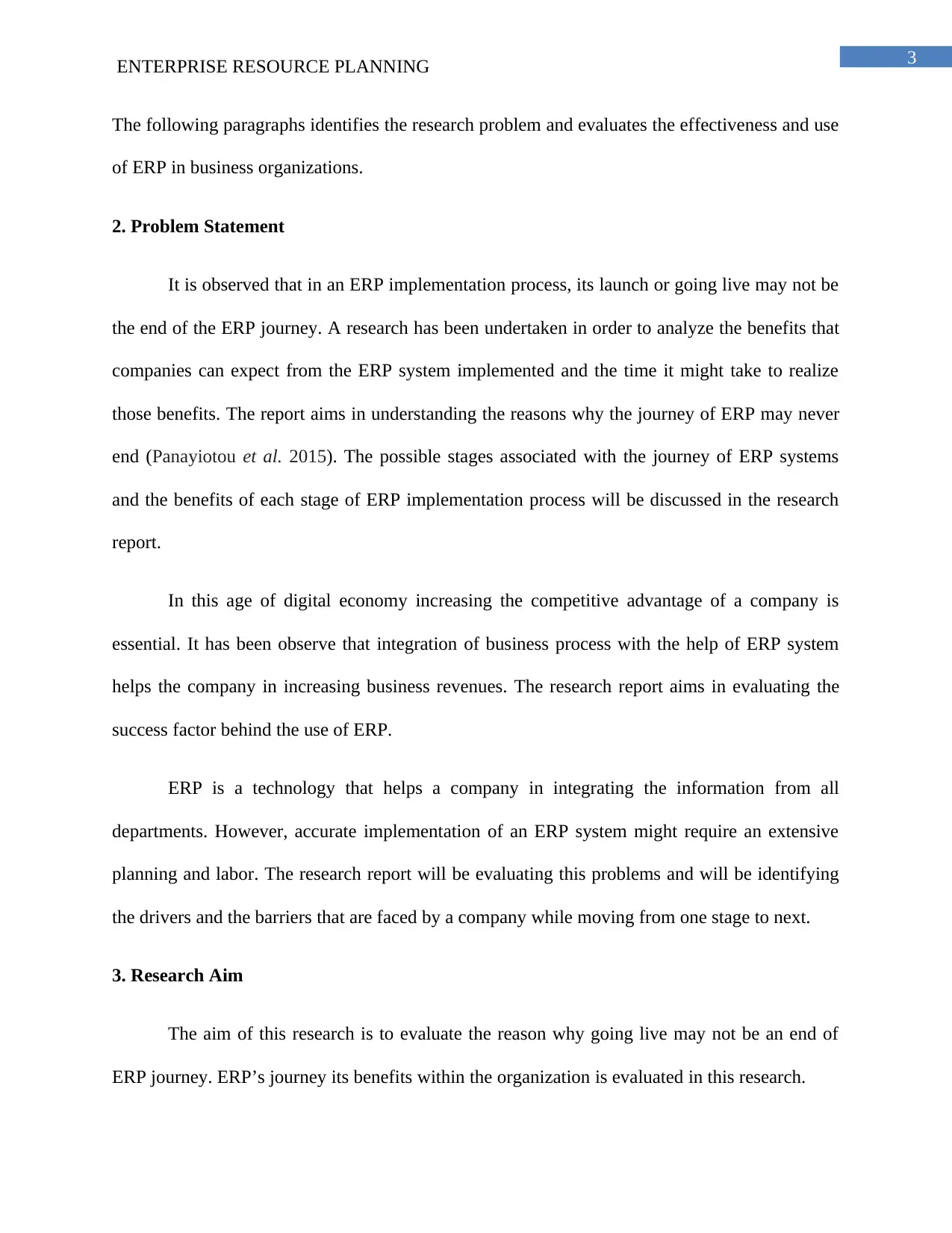
3ENTERPRISE RESOURCE PLANNING
The following paragraphs identifies the research problem and evaluates the effectiveness and use
of ERP in business organizations.
2. Problem Statement
It is observed that in an ERP implementation process, its launch or going live may not be
the end of the ERP journey. A research has been undertaken in order to analyze the benefits that
companies can expect from the ERP system implemented and the time it might take to realize
those benefits. The report aims in understanding the reasons why the journey of ERP may never
end (Panayiotou et al. 2015). The possible stages associated with the journey of ERP systems
and the benefits of each stage of ERP implementation process will be discussed in the research
report.
In this age of digital economy increasing the competitive advantage of a company is
essential. It has been observe that integration of business process with the help of ERP system
helps the company in increasing business revenues. The research report aims in evaluating the
success factor behind the use of ERP.
ERP is a technology that helps a company in integrating the information from all
departments. However, accurate implementation of an ERP system might require an extensive
planning and labor. The research report will be evaluating this problems and will be identifying
the drivers and the barriers that are faced by a company while moving from one stage to next.
3. Research Aim
The aim of this research is to evaluate the reason why going live may not be an end of
ERP journey. ERP’s journey its benefits within the organization is evaluated in this research.
The following paragraphs identifies the research problem and evaluates the effectiveness and use
of ERP in business organizations.
2. Problem Statement
It is observed that in an ERP implementation process, its launch or going live may not be
the end of the ERP journey. A research has been undertaken in order to analyze the benefits that
companies can expect from the ERP system implemented and the time it might take to realize
those benefits. The report aims in understanding the reasons why the journey of ERP may never
end (Panayiotou et al. 2015). The possible stages associated with the journey of ERP systems
and the benefits of each stage of ERP implementation process will be discussed in the research
report.
In this age of digital economy increasing the competitive advantage of a company is
essential. It has been observe that integration of business process with the help of ERP system
helps the company in increasing business revenues. The research report aims in evaluating the
success factor behind the use of ERP.
ERP is a technology that helps a company in integrating the information from all
departments. However, accurate implementation of an ERP system might require an extensive
planning and labor. The research report will be evaluating this problems and will be identifying
the drivers and the barriers that are faced by a company while moving from one stage to next.
3. Research Aim
The aim of this research is to evaluate the reason why going live may not be an end of
ERP journey. ERP’s journey its benefits within the organization is evaluated in this research.
Paraphrase This Document
Need a fresh take? Get an instant paraphrase of this document with our AI Paraphraser
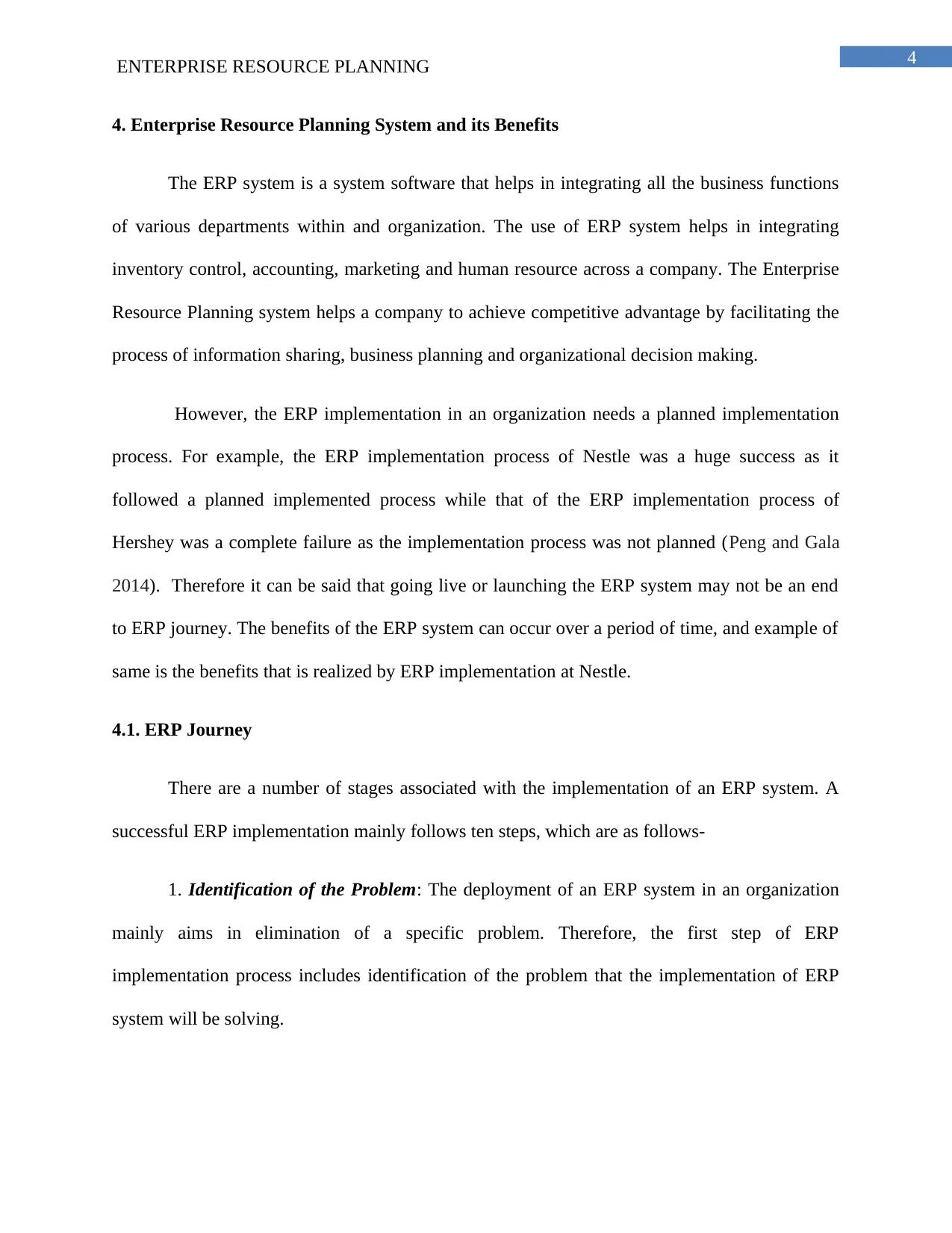
4ENTERPRISE RESOURCE PLANNING
4. Enterprise Resource Planning System and its Benefits
The ERP system is a system software that helps in integrating all the business functions
of various departments within and organization. The use of ERP system helps in integrating
inventory control, accounting, marketing and human resource across a company. The Enterprise
Resource Planning system helps a company to achieve competitive advantage by facilitating the
process of information sharing, business planning and organizational decision making.
However, the ERP implementation in an organization needs a planned implementation
process. For example, the ERP implementation process of Nestle was a huge success as it
followed a planned implemented process while that of the ERP implementation process of
Hershey was a complete failure as the implementation process was not planned (Peng and Gala
2014). Therefore it can be said that going live or launching the ERP system may not be an end
to ERP journey. The benefits of the ERP system can occur over a period of time, and example of
same is the benefits that is realized by ERP implementation at Nestle.
4.1. ERP Journey
There are a number of stages associated with the implementation of an ERP system. A
successful ERP implementation mainly follows ten steps, which are as follows-
1. Identification of the Problem: The deployment of an ERP system in an organization
mainly aims in elimination of a specific problem. Therefore, the first step of ERP
implementation process includes identification of the problem that the implementation of ERP
system will be solving.
4. Enterprise Resource Planning System and its Benefits
The ERP system is a system software that helps in integrating all the business functions
of various departments within and organization. The use of ERP system helps in integrating
inventory control, accounting, marketing and human resource across a company. The Enterprise
Resource Planning system helps a company to achieve competitive advantage by facilitating the
process of information sharing, business planning and organizational decision making.
However, the ERP implementation in an organization needs a planned implementation
process. For example, the ERP implementation process of Nestle was a huge success as it
followed a planned implemented process while that of the ERP implementation process of
Hershey was a complete failure as the implementation process was not planned (Peng and Gala
2014). Therefore it can be said that going live or launching the ERP system may not be an end
to ERP journey. The benefits of the ERP system can occur over a period of time, and example of
same is the benefits that is realized by ERP implementation at Nestle.
4.1. ERP Journey
There are a number of stages associated with the implementation of an ERP system. A
successful ERP implementation mainly follows ten steps, which are as follows-
1. Identification of the Problem: The deployment of an ERP system in an organization
mainly aims in elimination of a specific problem. Therefore, the first step of ERP
implementation process includes identification of the problem that the implementation of ERP
system will be solving.
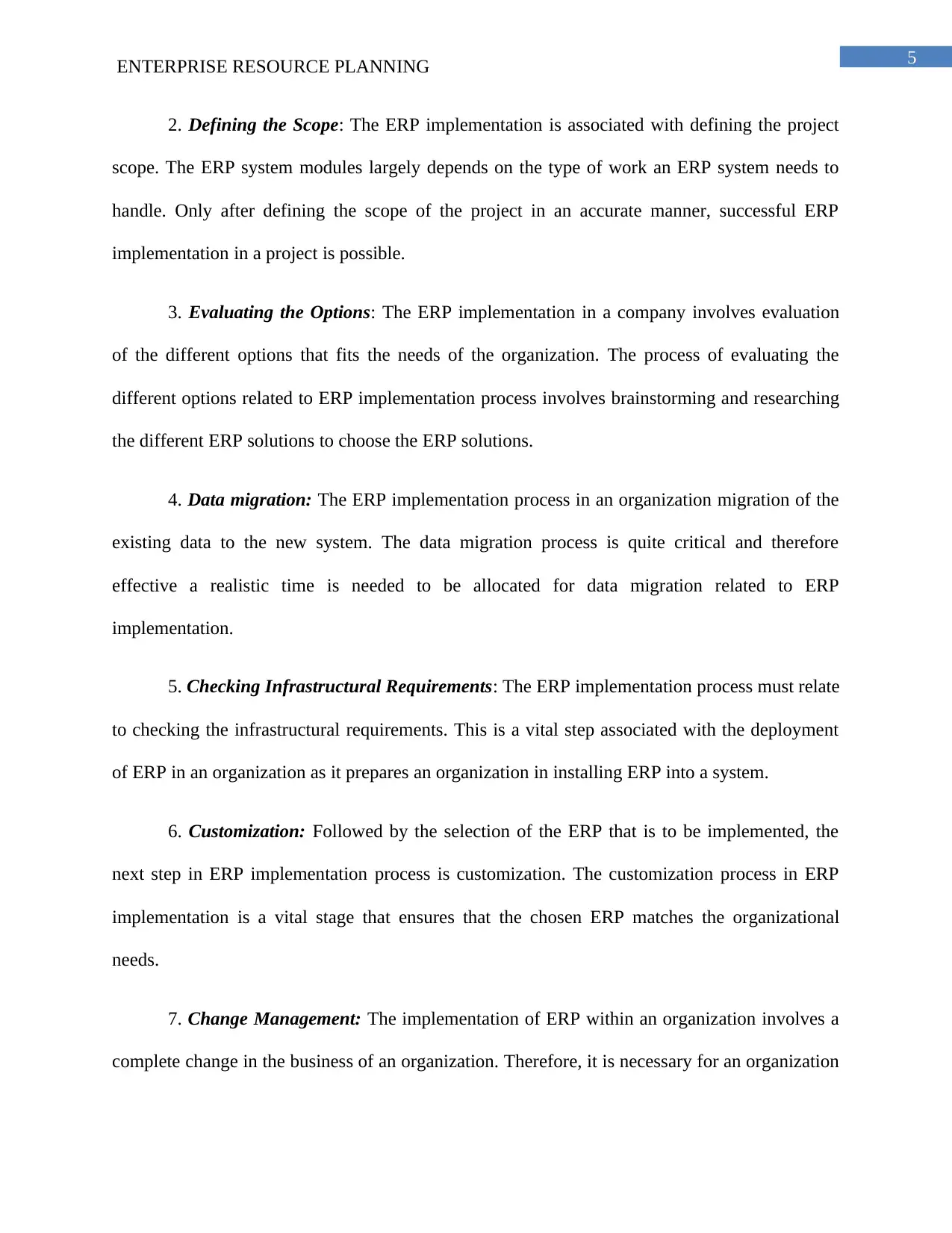
5ENTERPRISE RESOURCE PLANNING
2. Defining the Scope: The ERP implementation is associated with defining the project
scope. The ERP system modules largely depends on the type of work an ERP system needs to
handle. Only after defining the scope of the project in an accurate manner, successful ERP
implementation in a project is possible.
3. Evaluating the Options: The ERP implementation in a company involves evaluation
of the different options that fits the needs of the organization. The process of evaluating the
different options related to ERP implementation process involves brainstorming and researching
the different ERP solutions to choose the ERP solutions.
4. Data migration: The ERP implementation process in an organization migration of the
existing data to the new system. The data migration process is quite critical and therefore
effective a realistic time is needed to be allocated for data migration related to ERP
implementation.
5. Checking Infrastructural Requirements: The ERP implementation process must relate
to checking the infrastructural requirements. This is a vital step associated with the deployment
of ERP in an organization as it prepares an organization in installing ERP into a system.
6. Customization: Followed by the selection of the ERP that is to be implemented, the
next step in ERP implementation process is customization. The customization process in ERP
implementation is a vital stage that ensures that the chosen ERP matches the organizational
needs.
7. Change Management: The implementation of ERP within an organization involves a
complete change in the business of an organization. Therefore, it is necessary for an organization
2. Defining the Scope: The ERP implementation is associated with defining the project
scope. The ERP system modules largely depends on the type of work an ERP system needs to
handle. Only after defining the scope of the project in an accurate manner, successful ERP
implementation in a project is possible.
3. Evaluating the Options: The ERP implementation in a company involves evaluation
of the different options that fits the needs of the organization. The process of evaluating the
different options related to ERP implementation process involves brainstorming and researching
the different ERP solutions to choose the ERP solutions.
4. Data migration: The ERP implementation process in an organization migration of the
existing data to the new system. The data migration process is quite critical and therefore
effective a realistic time is needed to be allocated for data migration related to ERP
implementation.
5. Checking Infrastructural Requirements: The ERP implementation process must relate
to checking the infrastructural requirements. This is a vital step associated with the deployment
of ERP in an organization as it prepares an organization in installing ERP into a system.
6. Customization: Followed by the selection of the ERP that is to be implemented, the
next step in ERP implementation process is customization. The customization process in ERP
implementation is a vital stage that ensures that the chosen ERP matches the organizational
needs.
7. Change Management: The implementation of ERP within an organization involves a
complete change in the business of an organization. Therefore, it is necessary for an organization
⊘ This is a preview!⊘
Do you want full access?
Subscribe today to unlock all pages.

Trusted by 1+ million students worldwide
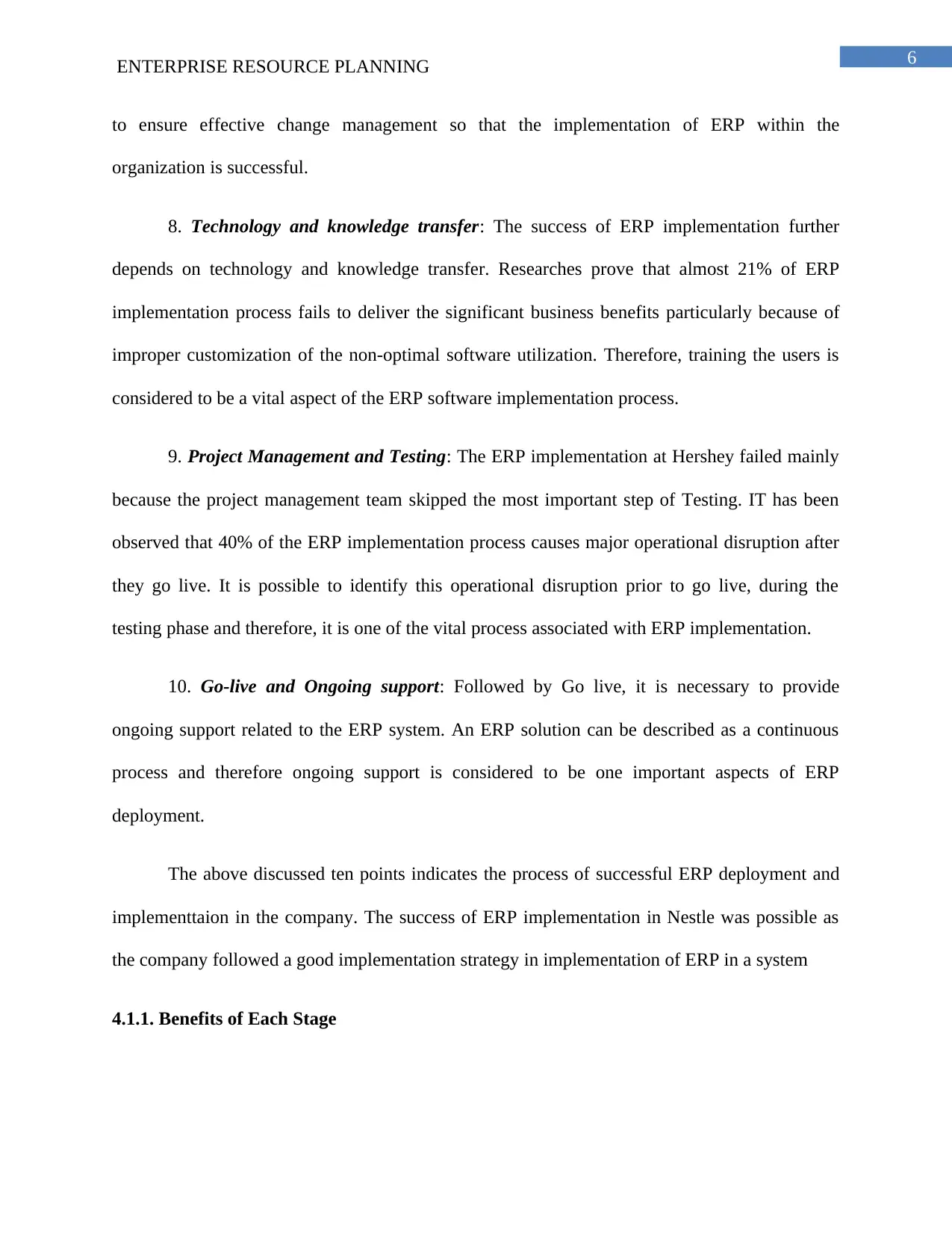
6ENTERPRISE RESOURCE PLANNING
to ensure effective change management so that the implementation of ERP within the
organization is successful.
8. Technology and knowledge transfer: The success of ERP implementation further
depends on technology and knowledge transfer. Researches prove that almost 21% of ERP
implementation process fails to deliver the significant business benefits particularly because of
improper customization of the non-optimal software utilization. Therefore, training the users is
considered to be a vital aspect of the ERP software implementation process.
9. Project Management and Testing: The ERP implementation at Hershey failed mainly
because the project management team skipped the most important step of Testing. IT has been
observed that 40% of the ERP implementation process causes major operational disruption after
they go live. It is possible to identify this operational disruption prior to go live, during the
testing phase and therefore, it is one of the vital process associated with ERP implementation.
10. Go-live and Ongoing support: Followed by Go live, it is necessary to provide
ongoing support related to the ERP system. An ERP solution can be described as a continuous
process and therefore ongoing support is considered to be one important aspects of ERP
deployment.
The above discussed ten points indicates the process of successful ERP deployment and
implementtaion in the company. The success of ERP implementation in Nestle was possible as
the company followed a good implementation strategy in implementation of ERP in a system
4.1.1. Benefits of Each Stage
to ensure effective change management so that the implementation of ERP within the
organization is successful.
8. Technology and knowledge transfer: The success of ERP implementation further
depends on technology and knowledge transfer. Researches prove that almost 21% of ERP
implementation process fails to deliver the significant business benefits particularly because of
improper customization of the non-optimal software utilization. Therefore, training the users is
considered to be a vital aspect of the ERP software implementation process.
9. Project Management and Testing: The ERP implementation at Hershey failed mainly
because the project management team skipped the most important step of Testing. IT has been
observed that 40% of the ERP implementation process causes major operational disruption after
they go live. It is possible to identify this operational disruption prior to go live, during the
testing phase and therefore, it is one of the vital process associated with ERP implementation.
10. Go-live and Ongoing support: Followed by Go live, it is necessary to provide
ongoing support related to the ERP system. An ERP solution can be described as a continuous
process and therefore ongoing support is considered to be one important aspects of ERP
deployment.
The above discussed ten points indicates the process of successful ERP deployment and
implementtaion in the company. The success of ERP implementation in Nestle was possible as
the company followed a good implementation strategy in implementation of ERP in a system
4.1.1. Benefits of Each Stage
Paraphrase This Document
Need a fresh take? Get an instant paraphrase of this document with our AI Paraphraser
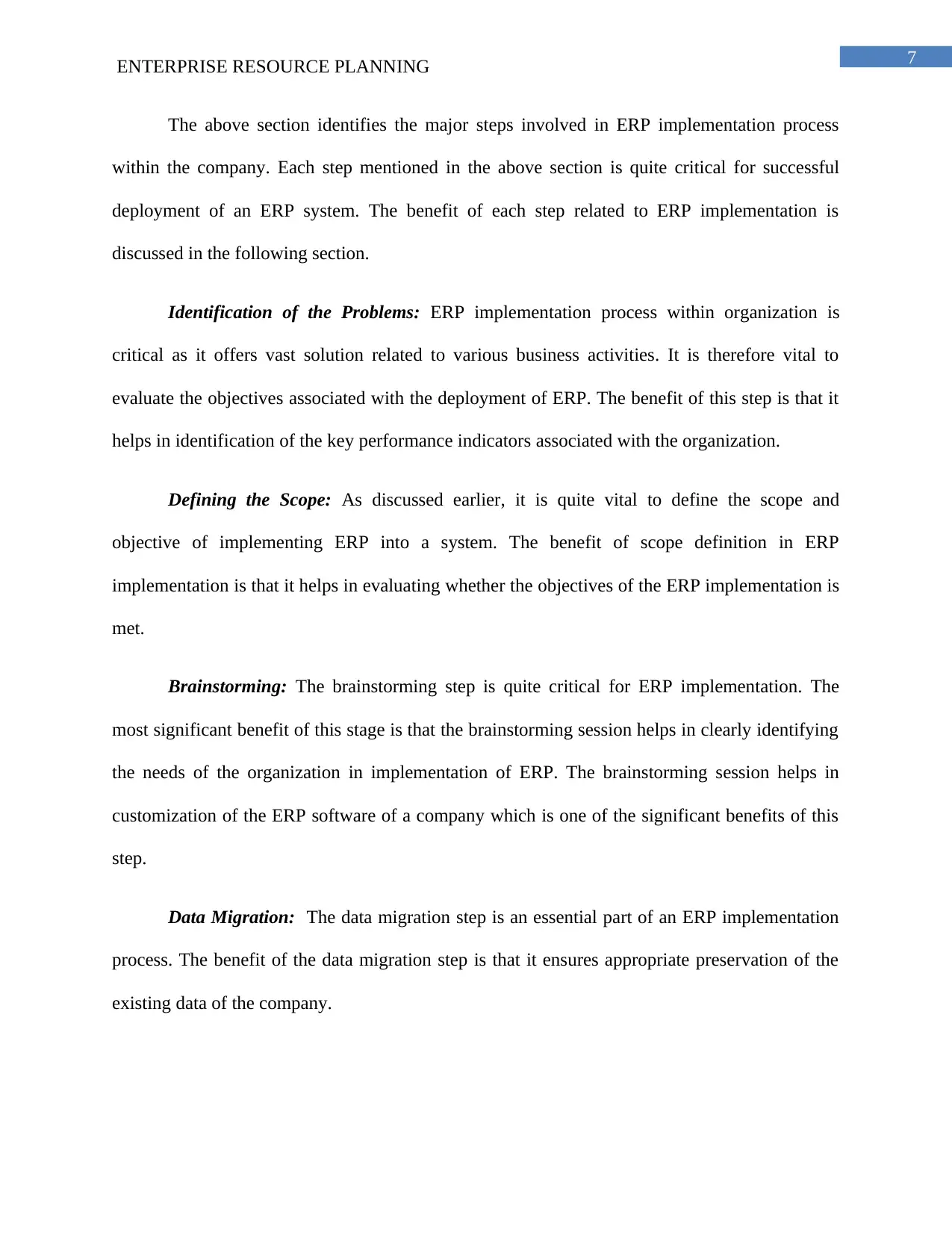
7ENTERPRISE RESOURCE PLANNING
The above section identifies the major steps involved in ERP implementation process
within the company. Each step mentioned in the above section is quite critical for successful
deployment of an ERP system. The benefit of each step related to ERP implementation is
discussed in the following section.
Identification of the Problems: ERP implementation process within organization is
critical as it offers vast solution related to various business activities. It is therefore vital to
evaluate the objectives associated with the deployment of ERP. The benefit of this step is that it
helps in identification of the key performance indicators associated with the organization.
Defining the Scope: As discussed earlier, it is quite vital to define the scope and
objective of implementing ERP into a system. The benefit of scope definition in ERP
implementation is that it helps in evaluating whether the objectives of the ERP implementation is
met.
Brainstorming: The brainstorming step is quite critical for ERP implementation. The
most significant benefit of this stage is that the brainstorming session helps in clearly identifying
the needs of the organization in implementation of ERP. The brainstorming session helps in
customization of the ERP software of a company which is one of the significant benefits of this
step.
Data Migration: The data migration step is an essential part of an ERP implementation
process. The benefit of the data migration step is that it ensures appropriate preservation of the
existing data of the company.
The above section identifies the major steps involved in ERP implementation process
within the company. Each step mentioned in the above section is quite critical for successful
deployment of an ERP system. The benefit of each step related to ERP implementation is
discussed in the following section.
Identification of the Problems: ERP implementation process within organization is
critical as it offers vast solution related to various business activities. It is therefore vital to
evaluate the objectives associated with the deployment of ERP. The benefit of this step is that it
helps in identification of the key performance indicators associated with the organization.
Defining the Scope: As discussed earlier, it is quite vital to define the scope and
objective of implementing ERP into a system. The benefit of scope definition in ERP
implementation is that it helps in evaluating whether the objectives of the ERP implementation is
met.
Brainstorming: The brainstorming step is quite critical for ERP implementation. The
most significant benefit of this stage is that the brainstorming session helps in clearly identifying
the needs of the organization in implementation of ERP. The brainstorming session helps in
customization of the ERP software of a company which is one of the significant benefits of this
step.
Data Migration: The data migration step is an essential part of an ERP implementation
process. The benefit of the data migration step is that it ensures appropriate preservation of the
existing data of the company.
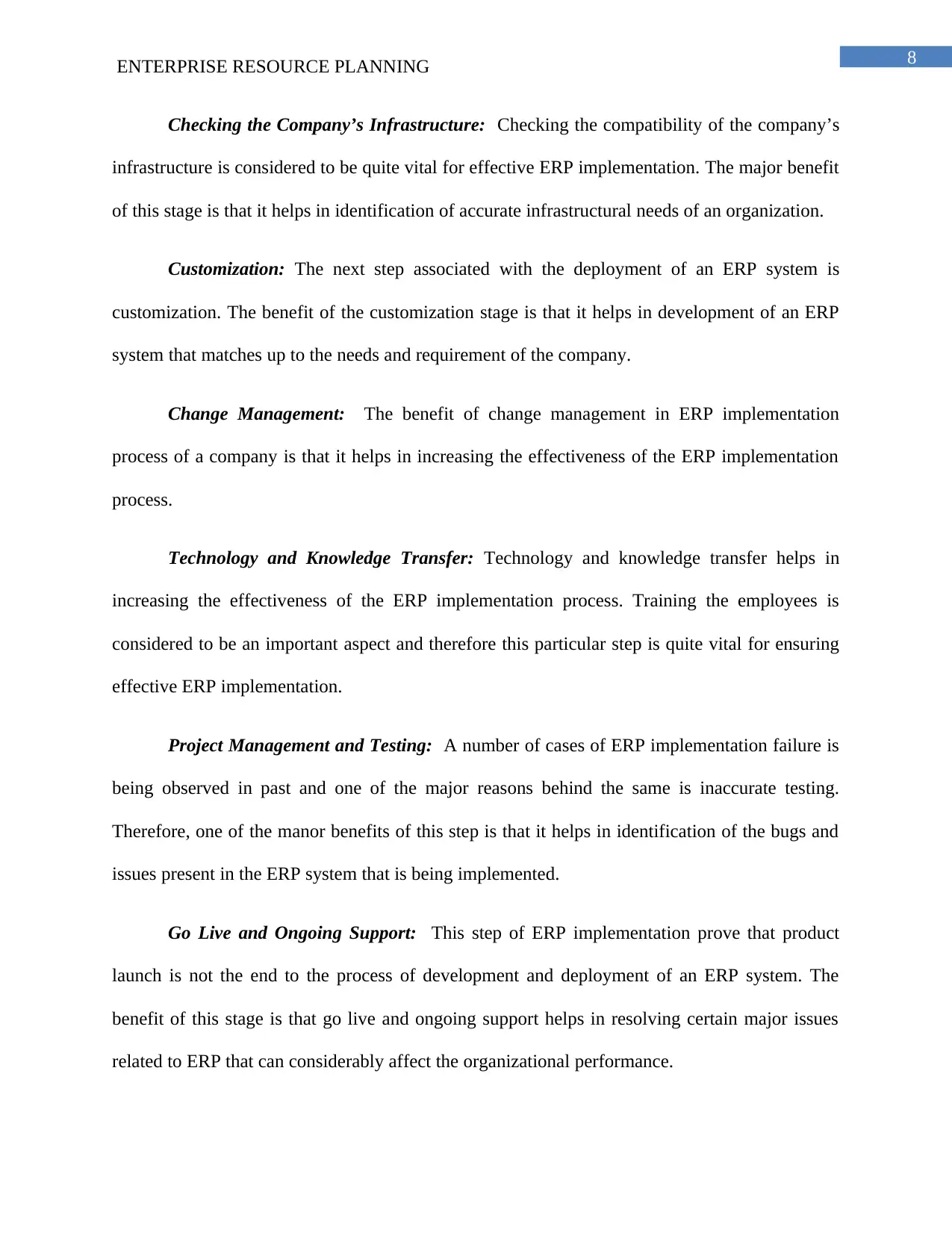
8ENTERPRISE RESOURCE PLANNING
Checking the Company’s Infrastructure: Checking the compatibility of the company’s
infrastructure is considered to be quite vital for effective ERP implementation. The major benefit
of this stage is that it helps in identification of accurate infrastructural needs of an organization.
Customization: The next step associated with the deployment of an ERP system is
customization. The benefit of the customization stage is that it helps in development of an ERP
system that matches up to the needs and requirement of the company.
Change Management: The benefit of change management in ERP implementation
process of a company is that it helps in increasing the effectiveness of the ERP implementation
process.
Technology and Knowledge Transfer: Technology and knowledge transfer helps in
increasing the effectiveness of the ERP implementation process. Training the employees is
considered to be an important aspect and therefore this particular step is quite vital for ensuring
effective ERP implementation.
Project Management and Testing: A number of cases of ERP implementation failure is
being observed in past and one of the major reasons behind the same is inaccurate testing.
Therefore, one of the manor benefits of this step is that it helps in identification of the bugs and
issues present in the ERP system that is being implemented.
Go Live and Ongoing Support: This step of ERP implementation prove that product
launch is not the end to the process of development and deployment of an ERP system. The
benefit of this stage is that go live and ongoing support helps in resolving certain major issues
related to ERP that can considerably affect the organizational performance.
Checking the Company’s Infrastructure: Checking the compatibility of the company’s
infrastructure is considered to be quite vital for effective ERP implementation. The major benefit
of this stage is that it helps in identification of accurate infrastructural needs of an organization.
Customization: The next step associated with the deployment of an ERP system is
customization. The benefit of the customization stage is that it helps in development of an ERP
system that matches up to the needs and requirement of the company.
Change Management: The benefit of change management in ERP implementation
process of a company is that it helps in increasing the effectiveness of the ERP implementation
process.
Technology and Knowledge Transfer: Technology and knowledge transfer helps in
increasing the effectiveness of the ERP implementation process. Training the employees is
considered to be an important aspect and therefore this particular step is quite vital for ensuring
effective ERP implementation.
Project Management and Testing: A number of cases of ERP implementation failure is
being observed in past and one of the major reasons behind the same is inaccurate testing.
Therefore, one of the manor benefits of this step is that it helps in identification of the bugs and
issues present in the ERP system that is being implemented.
Go Live and Ongoing Support: This step of ERP implementation prove that product
launch is not the end to the process of development and deployment of an ERP system. The
benefit of this stage is that go live and ongoing support helps in resolving certain major issues
related to ERP that can considerably affect the organizational performance.
⊘ This is a preview!⊘
Do you want full access?
Subscribe today to unlock all pages.

Trusted by 1+ million students worldwide
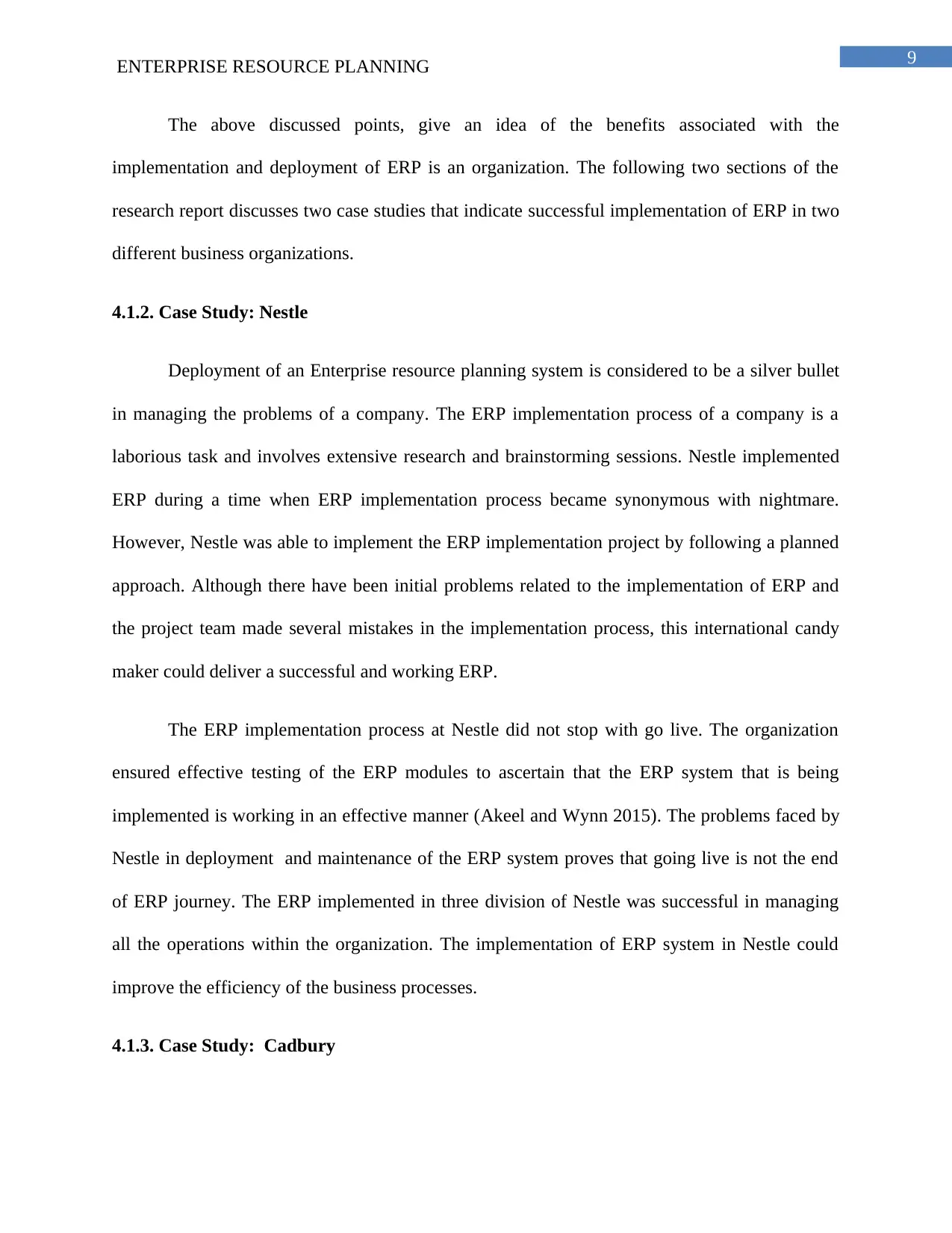
9ENTERPRISE RESOURCE PLANNING
The above discussed points, give an idea of the benefits associated with the
implementation and deployment of ERP is an organization. The following two sections of the
research report discusses two case studies that indicate successful implementation of ERP in two
different business organizations.
4.1.2. Case Study: Nestle
Deployment of an Enterprise resource planning system is considered to be a silver bullet
in managing the problems of a company. The ERP implementation process of a company is a
laborious task and involves extensive research and brainstorming sessions. Nestle implemented
ERP during a time when ERP implementation process became synonymous with nightmare.
However, Nestle was able to implement the ERP implementation project by following a planned
approach. Although there have been initial problems related to the implementation of ERP and
the project team made several mistakes in the implementation process, this international candy
maker could deliver a successful and working ERP.
The ERP implementation process at Nestle did not stop with go live. The organization
ensured effective testing of the ERP modules to ascertain that the ERP system that is being
implemented is working in an effective manner (Akeel and Wynn 2015). The problems faced by
Nestle in deployment and maintenance of the ERP system proves that going live is not the end
of ERP journey. The ERP implemented in three division of Nestle was successful in managing
all the operations within the organization. The implementation of ERP system in Nestle could
improve the efficiency of the business processes.
4.1.3. Case Study: Cadbury
The above discussed points, give an idea of the benefits associated with the
implementation and deployment of ERP is an organization. The following two sections of the
research report discusses two case studies that indicate successful implementation of ERP in two
different business organizations.
4.1.2. Case Study: Nestle
Deployment of an Enterprise resource planning system is considered to be a silver bullet
in managing the problems of a company. The ERP implementation process of a company is a
laborious task and involves extensive research and brainstorming sessions. Nestle implemented
ERP during a time when ERP implementation process became synonymous with nightmare.
However, Nestle was able to implement the ERP implementation project by following a planned
approach. Although there have been initial problems related to the implementation of ERP and
the project team made several mistakes in the implementation process, this international candy
maker could deliver a successful and working ERP.
The ERP implementation process at Nestle did not stop with go live. The organization
ensured effective testing of the ERP modules to ascertain that the ERP system that is being
implemented is working in an effective manner (Akeel and Wynn 2015). The problems faced by
Nestle in deployment and maintenance of the ERP system proves that going live is not the end
of ERP journey. The ERP implemented in three division of Nestle was successful in managing
all the operations within the organization. The implementation of ERP system in Nestle could
improve the efficiency of the business processes.
4.1.3. Case Study: Cadbury
Paraphrase This Document
Need a fresh take? Get an instant paraphrase of this document with our AI Paraphraser
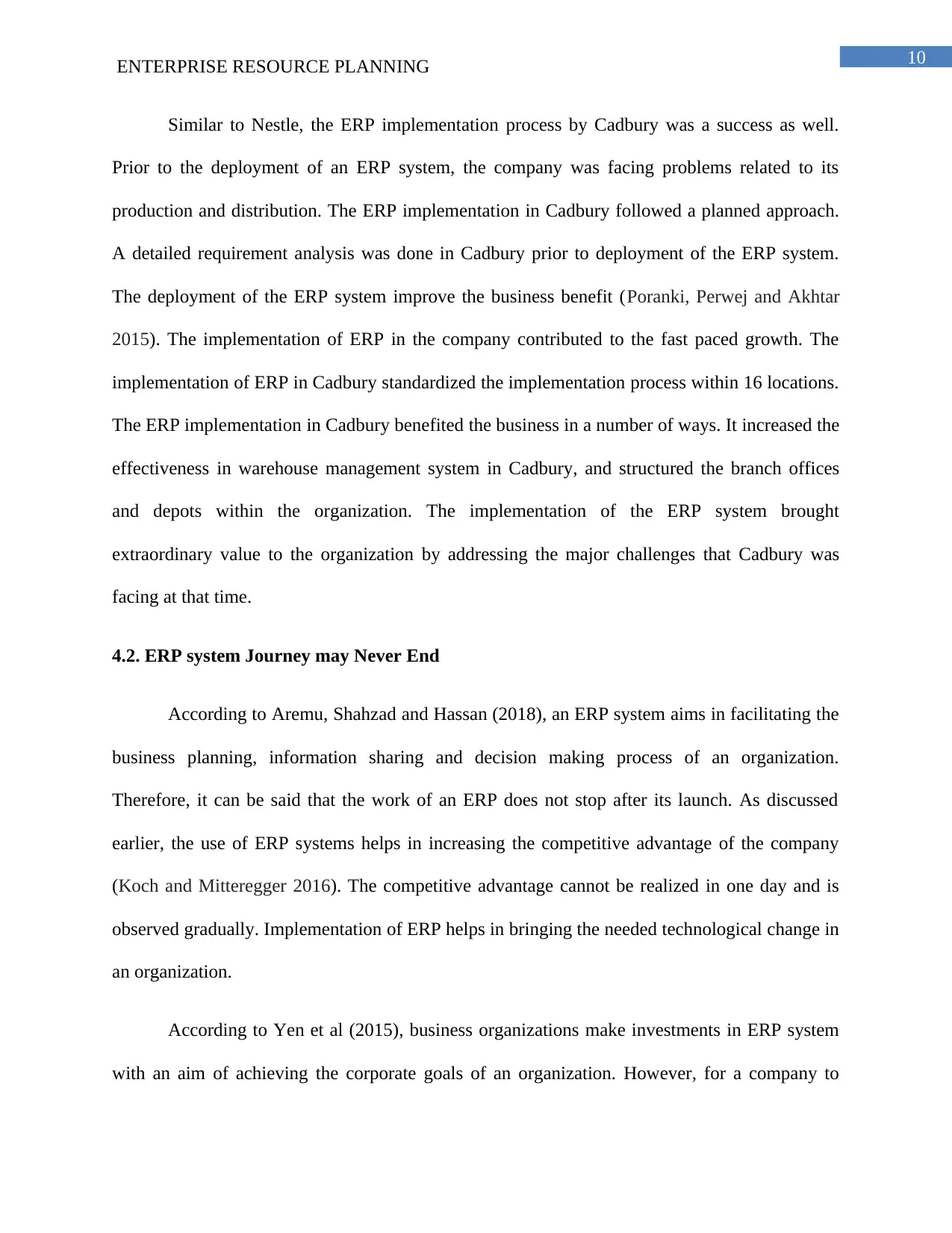
10ENTERPRISE RESOURCE PLANNING
Similar to Nestle, the ERP implementation process by Cadbury was a success as well.
Prior to the deployment of an ERP system, the company was facing problems related to its
production and distribution. The ERP implementation in Cadbury followed a planned approach.
A detailed requirement analysis was done in Cadbury prior to deployment of the ERP system.
The deployment of the ERP system improve the business benefit (Poranki, Perwej and Akhtar
2015). The implementation of ERP in the company contributed to the fast paced growth. The
implementation of ERP in Cadbury standardized the implementation process within 16 locations.
The ERP implementation in Cadbury benefited the business in a number of ways. It increased the
effectiveness in warehouse management system in Cadbury, and structured the branch offices
and depots within the organization. The implementation of the ERP system brought
extraordinary value to the organization by addressing the major challenges that Cadbury was
facing at that time.
4.2. ERP system Journey may Never End
According to Aremu, Shahzad and Hassan (2018), an ERP system aims in facilitating the
business planning, information sharing and decision making process of an organization.
Therefore, it can be said that the work of an ERP does not stop after its launch. As discussed
earlier, the use of ERP systems helps in increasing the competitive advantage of the company
(Koch and Mitteregger 2016). The competitive advantage cannot be realized in one day and is
observed gradually. Implementation of ERP helps in bringing the needed technological change in
an organization.
According to Yen et al (2015), business organizations make investments in ERP system
with an aim of achieving the corporate goals of an organization. However, for a company to
Similar to Nestle, the ERP implementation process by Cadbury was a success as well.
Prior to the deployment of an ERP system, the company was facing problems related to its
production and distribution. The ERP implementation in Cadbury followed a planned approach.
A detailed requirement analysis was done in Cadbury prior to deployment of the ERP system.
The deployment of the ERP system improve the business benefit (Poranki, Perwej and Akhtar
2015). The implementation of ERP in the company contributed to the fast paced growth. The
implementation of ERP in Cadbury standardized the implementation process within 16 locations.
The ERP implementation in Cadbury benefited the business in a number of ways. It increased the
effectiveness in warehouse management system in Cadbury, and structured the branch offices
and depots within the organization. The implementation of the ERP system brought
extraordinary value to the organization by addressing the major challenges that Cadbury was
facing at that time.
4.2. ERP system Journey may Never End
According to Aremu, Shahzad and Hassan (2018), an ERP system aims in facilitating the
business planning, information sharing and decision making process of an organization.
Therefore, it can be said that the work of an ERP does not stop after its launch. As discussed
earlier, the use of ERP systems helps in increasing the competitive advantage of the company
(Koch and Mitteregger 2016). The competitive advantage cannot be realized in one day and is
observed gradually. Implementation of ERP helps in bringing the needed technological change in
an organization.
According to Yen et al (2015), business organizations make investments in ERP system
with an aim of achieving the corporate goals of an organization. However, for a company to
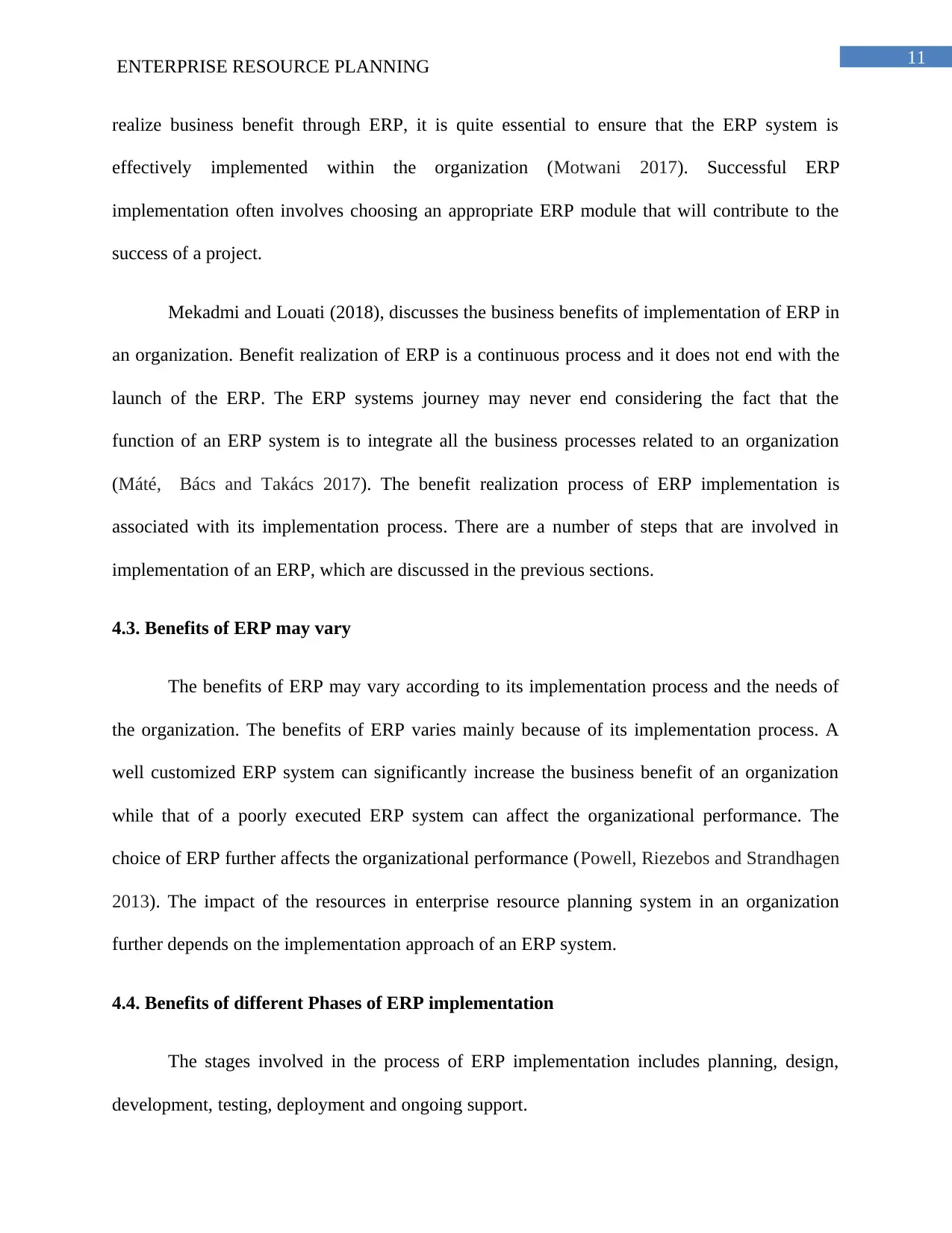
11ENTERPRISE RESOURCE PLANNING
realize business benefit through ERP, it is quite essential to ensure that the ERP system is
effectively implemented within the organization (Motwani 2017). Successful ERP
implementation often involves choosing an appropriate ERP module that will contribute to the
success of a project.
Mekadmi and Louati (2018), discusses the business benefits of implementation of ERP in
an organization. Benefit realization of ERP is a continuous process and it does not end with the
launch of the ERP. The ERP systems journey may never end considering the fact that the
function of an ERP system is to integrate all the business processes related to an organization
(Máté, Bács and Takács 2017). The benefit realization process of ERP implementation is
associated with its implementation process. There are a number of steps that are involved in
implementation of an ERP, which are discussed in the previous sections.
4.3. Benefits of ERP may vary
The benefits of ERP may vary according to its implementation process and the needs of
the organization. The benefits of ERP varies mainly because of its implementation process. A
well customized ERP system can significantly increase the business benefit of an organization
while that of a poorly executed ERP system can affect the organizational performance. The
choice of ERP further affects the organizational performance (Powell, Riezebos and Strandhagen
2013). The impact of the resources in enterprise resource planning system in an organization
further depends on the implementation approach of an ERP system.
4.4. Benefits of different Phases of ERP implementation
The stages involved in the process of ERP implementation includes planning, design,
development, testing, deployment and ongoing support.
realize business benefit through ERP, it is quite essential to ensure that the ERP system is
effectively implemented within the organization (Motwani 2017). Successful ERP
implementation often involves choosing an appropriate ERP module that will contribute to the
success of a project.
Mekadmi and Louati (2018), discusses the business benefits of implementation of ERP in
an organization. Benefit realization of ERP is a continuous process and it does not end with the
launch of the ERP. The ERP systems journey may never end considering the fact that the
function of an ERP system is to integrate all the business processes related to an organization
(Máté, Bács and Takács 2017). The benefit realization process of ERP implementation is
associated with its implementation process. There are a number of steps that are involved in
implementation of an ERP, which are discussed in the previous sections.
4.3. Benefits of ERP may vary
The benefits of ERP may vary according to its implementation process and the needs of
the organization. The benefits of ERP varies mainly because of its implementation process. A
well customized ERP system can significantly increase the business benefit of an organization
while that of a poorly executed ERP system can affect the organizational performance. The
choice of ERP further affects the organizational performance (Powell, Riezebos and Strandhagen
2013). The impact of the resources in enterprise resource planning system in an organization
further depends on the implementation approach of an ERP system.
4.4. Benefits of different Phases of ERP implementation
The stages involved in the process of ERP implementation includes planning, design,
development, testing, deployment and ongoing support.
⊘ This is a preview!⊘
Do you want full access?
Subscribe today to unlock all pages.

Trusted by 1+ million students worldwide
1 out of 17
Related Documents
Your All-in-One AI-Powered Toolkit for Academic Success.
+13062052269
info@desklib.com
Available 24*7 on WhatsApp / Email
![[object Object]](/_next/static/media/star-bottom.7253800d.svg)
Unlock your academic potential
Copyright © 2020–2025 A2Z Services. All Rights Reserved. Developed and managed by ZUCOL.




